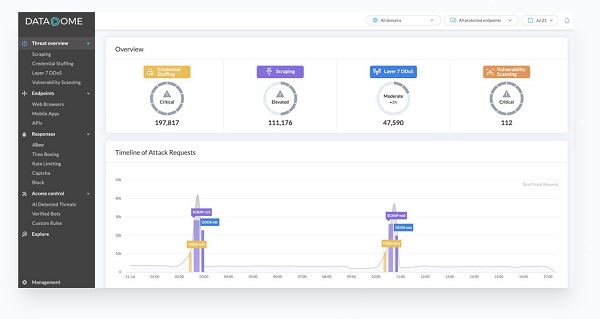SQL Injection: Types, Examples, Prevention
For many businesses and users alike, the threat of cyber attacks is as rife as it’s ever been. With more people online, it means there are more vulnerabilities and plenty of cyber thieves who are willing to take advantage of that.
An SQL injection is a common opportunity for attack in order to help access sensitive company data or personal information if it’s an individual being exploited. The impact of which can be damaging beyond repair for some organizations in particular.
With that in mind, businesses and those who exist online need to heed more caution when it comes to these types of malicious attacks. In this guide, we’ll explore what an SQL injection is, the types of this attack vector, and examples of it.
We’ll also explore some of the effective ways in which these attacks can be prevented to protect your business reputation and more importantly, the confidential data of your company and its customers in 2022.
What is a SQL injection?
Before diving into an SQL injection, what is SQL? It’s a standardized language that helps to build customizable data views by accessing and manipulating databases. An SQL query is generated and executes various tasks such as record removal, retrieving data, and updating existing user information.
An SQL injection uses malicious SQL code in order to manipulate the database from the backend and to access the information that is most sensitive for a business or individual. The information that the cybercriminal could collect may be company data, private customer information, and user lists. All data that could be detrimental to the business if leaked.
SQL injections or otherwise known as SQLi, are a frequent option for cyber attacks. Cybersecurity Ventures found that cybercrime costs worldwide were expected to grow by 15% per year over the next five years. The cost of which results in over $10.5 trillion per year by 2025. It’s a serious problem that more businesses need to be cautious of.
Types of SQL injections
There are a number of SQL injection types, three in fact. These three categories are In-band SQLi, Inferential SQLi, and Out-of-band SQLi. The method of which is used to access the backend data and the damage caused will help classify which category a particular SQL injection falls under.
Let’s look at what is involved with each type of injection before looking at some prime examples of SQL injections.
In-band SQLi
With an in-band SQLi attack, the individual attacking the database will use the same channel to launch the attack and collect the data. It’s one of the more simple of the three categories and can be further broken down into two variations of the method:
- Union-based SQLi
Uses the UNION SQL operator to bring together multiple statements that are generated by the database and as a result, gets a single HTTP response. The attacker can then take away information from the database by extending the results made with the query.
- Error-based
An error-based SQLi will perform various actions in order to get error messages. The attacker could then use the information provided by the errors messages in order to understand and gather intel on the structure of the database to exploit it in some way.
Inferential SQLi
An inferential SQLi is one where the attacker will send data payloads toward the server. As a result, the server responds and that can provide further intel on the stability of the server’s structure.
This is what’s referred to as a blind SQLi due to the data not transferring from the website’s database to the attacker themselves. Instead, they rely on behavioral patterns and responses from the servers themselves. These injection types can be further classified as:
- Time-based
The attacker will send a SQL query to the database where the delay before the database reacts can be telling information about whether the query was true or false. They don’t need to rely on any data from the database with this method.
- Boolean
A SQL query is sent to prompt the application and return a result. Again, like the time-based one, the result varies depending on whether the query comes back true or false. From the result, a HTTP response will either stay unchanged or will change.
Out-of-band SQLi
Finally, this SQLi is only possible if certain features have been enabled within the database server by the web application itself. It’s an alternative SQLi and relies on the server to create DNS or HTTP requests in order to transfer data to the attacker themselves.
SQL injection example
There are a number of SQL injection examples out there that can show you what you should be looking out for when it comes to this type of malicious attack.
W3Schools is a great site for providing helpful information on all things cybersecurity-related. They’ve got a few examples of SQL injections in various formats. For example, when it comes to an SQL being used in web pages, the injection occurs when you ask a user for input.
This could be adding in their username/ID. Attackers will instead of entering a username/ID, will give an SQL statement that will run on the website’s database. Here’s an example that W3Schools gives:
Where there’s no prevention for users putting in an incorrect input, the attacker may enter something like
User ID: 105 or 1=1
This SQL statement that comes from this may seem harmless but in fact, could turn up a table that contains certain names and even passwords.
SELECT UserId, Name, Password FROM Users WHERE UserId = 105 or 1=1;
As a result, a hacker could then have access to a variety of user names and passwords within the database.
SQLI prevention and mitigation
With SQLi being just one of many cyberattack methods, how can these be prevented? As a business, you want to be actively reducing the risks of an attack, which can be done if the right steps are taken. Here are a few ways to prevent SQL injection opportunities within your business this year.
-
Help avoid illegitimate user inputs
The most efficient way to avoid your database or information of any type being exposed is to make it impossible for users to write code into the inputs.
Input validation or sanitization as it’s referred to is a good way to help recognize illegitimate user inputs so that they can go no further with their attempts to access information. However, the downside of this effort is that it’s not foolproof. As a result, it can end up generating a lot of false positives that may affect genuine user experience and app functionality.
-
Prepare parameterized queries and prepared statements.
Instead of making it a free for all when it comes to your user inputs, set parameters ahead of time to prevent the problem from occurring. These prepared parameterized queries will stop the attackers from being able to input their own code and having SQL statements already prepared can further prevent any data from going loose.

Yes, it requires a little extra effort on your coding front but it’s that extra effort that could make a difference when it comes to preventing a lethal SQLi from stealing data.
-
Utilize the effectiveness of a web application firewall.
Another way to help prevent these issues from occurring is by using a web application firewall or a WAF as it’s referred to for short. This is great for helping filter out threats like SQLi, along with other malicious threats online.
A lot of modern web application firewalls will be integrated with further security features and can often help weed out any SQL queries and patch up any existing vulnerabilities within the database or servers of the website.
Why protecting your business from cyberattacks is crucial in 2022
There has certainly been an increase in data breaches across many companies both big and small. The fallout from a data leak is damaging, to say the least, and as a result, it can lose the customer’s trust in the business when their information has been exposed or stolen. With that being said, it’s important to make every effort to protect your business from cyberattacks.
Further preventative measures can be taken to ensure it doesn’t happen to your business and this includes any of the following.
Change passwords regularly - When it comes to passwords, these tend to be weak for many users within a company. Some even use the same passwords across a variety of logins. Make sure passwords are changed regularly and where possible, identify stronger password combinations.
Use a firewall for extra protection - A firewall is going to provide that extra protection to your business, especially when it comes to vulnerabilities within your business’s technological infrasture
Limit your data collection - Be careful of what data you’re collecting and only collect what you need.
By actively preventing these problems from occurring, cyber attackers are less likely to be successful in their attempts to steal your data.
Author Bio: Natalie Redman (LinkedIn)
Freelance writer for many clients across multiple industries. Natalie has two years of copywriting experience. Natalie has a wide range of experience copywriting for web pages for businesses across many industries. She’s also an owner of two blog websites and a Youtube content creator.

